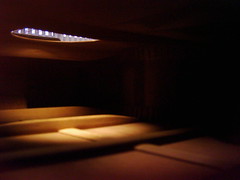Feel like blogging...let it b-e-E
I know I've kinda let this blog rest in peace for some time now, but I have the urge to record some stuff here for what it's worth.
I spent over a year and a half experimenting with Just Intonation and experienced a major shift in both my hearing and my consciousness. I'm now back to straight frets again but have found a very simple solution to achieve pure 3rds and 6ths in "almost" standard tuning.
I'm calling it the "Let it Be" tuning or more accurately let it b-e-E, because it involves slight shifts in the b and e strings...both high e and low E. Seems like a lot of trouble I went through, ripping my frets off then glueing various curved wire on the fretboard. There was a deep and rich purity I found there but I had to admit some limitations in the modern setting. This new arrangement does require some selectivity in comparison to standard tuning but it does contain much familiar territory fingering wise while allowing pure (and very near pure) 3rds and 6ths round the "circle of 5ths"
I'm not sure if anyone reading this will even care (if there is anyone reading this) but I like the idea of having it recorded here and accessible. Need I go into how Equal Temperament is merely an approximation of Just Intervals? Need I point out that though the "4th" and "5th" in the tempered system are only 2% "off" that the other more emotional intervals are upwards to 15% off? I think for the musician seeking the truth in these matters that the harmonic world speaks for itself and should leave no further question in one's mind as to the reality of these natural tones.
What I've discovered is what could be termed a "hybrid". So I may as well just dive in.
Tune your A - D - and G as you normally would. (A4=440 is fine although I've been experimenting with A4=432) but that is another post. So we have 3 strings tuned in tempered 4ths from which we can derive the Root 5th of several (in not all) Major chords. Fine!
Now to tune (or should I say "tame" the dreaded B string! This is where we are going off the conventional rails of modern western intonation. Don't get the "B" from the 4th fret on the G! I say another way: The 4th fret of the G string is not a pure ratio of the G and therefore shall NOT be used to tune this pivotal string! We shall instead look to the natural harmonic world and struggle and strain to produce the 5/4 harmonic which is APPROXIMATELY found near the 4th fret, or 9th fret or any other location which divides the string in 5 parts. When we tune the "B" to this tone we are left with a B which is around 14% of a tempered semi tone lower than standard. So now when you play your D G and B strings together you will hear a pure major chord. This B string is now firstly devoted to being used as a pure 3rd in Major chords. We shall see how else it can be used shortly.
So we have a lower than usual B! what shall we do with the E? Well how be we tune it like usual to the B? Great! now between your G string and high E we have a just major 6th! OK now we have one more string to deal with and that is the low E. Well why don't we simply tune it to the high E?
So a way to check these freq. is to play the 4th fret harmonic an the A string and match it to the "C#" (2nd fret on B). Then play the 4th fret harmonic on the D String and match it to the "F#" (2nd fret on the high E). These harmonics are a lot easier to access than the G string because of their thickness. You can also match the harmonic on around the 3rd fret of the low E with the 12th fret harmonic of the B string. Voila! you are ready to play around the "circle of 5th" (because to the tempered "mid section" of A - D - G ) with the B - E - E which have been justified to reflect a more natural tone.
now if you play your low E with your G you will get a VERY close to pure minor 3rd. because the E is "lowered" it creates a wider interval (which is what we want for minor 3rds) - we want narrower intervals for major 3rds.
something to remember is that since we have dedicated the B - E - E to these tones we may not be able to use them as octaves or 5ths
I spent over a year and a half experimenting with Just Intonation and experienced a major shift in both my hearing and my consciousness. I'm now back to straight frets again but have found a very simple solution to achieve pure 3rds and 6ths in "almost" standard tuning.
I'm calling it the "Let it Be" tuning or more accurately let it b-e-E, because it involves slight shifts in the b and e strings...both high e and low E. Seems like a lot of trouble I went through, ripping my frets off then glueing various curved wire on the fretboard. There was a deep and rich purity I found there but I had to admit some limitations in the modern setting. This new arrangement does require some selectivity in comparison to standard tuning but it does contain much familiar territory fingering wise while allowing pure (and very near pure) 3rds and 6ths round the "circle of 5ths"
I'm not sure if anyone reading this will even care (if there is anyone reading this) but I like the idea of having it recorded here and accessible. Need I go into how Equal Temperament is merely an approximation of Just Intervals? Need I point out that though the "4th" and "5th" in the tempered system are only 2% "off" that the other more emotional intervals are upwards to 15% off? I think for the musician seeking the truth in these matters that the harmonic world speaks for itself and should leave no further question in one's mind as to the reality of these natural tones.
What I've discovered is what could be termed a "hybrid". So I may as well just dive in.
Tune your A - D - and G as you normally would. (A4=440 is fine although I've been experimenting with A4=432) but that is another post. So we have 3 strings tuned in tempered 4ths from which we can derive the Root 5th of several (in not all) Major chords. Fine!
Now to tune (or should I say "tame" the dreaded B string! This is where we are going off the conventional rails of modern western intonation. Don't get the "B" from the 4th fret on the G! I say another way: The 4th fret of the G string is not a pure ratio of the G and therefore shall NOT be used to tune this pivotal string! We shall instead look to the natural harmonic world and struggle and strain to produce the 5/4 harmonic which is APPROXIMATELY found near the 4th fret, or 9th fret or any other location which divides the string in 5 parts. When we tune the "B" to this tone we are left with a B which is around 14% of a tempered semi tone lower than standard. So now when you play your D G and B strings together you will hear a pure major chord. This B string is now firstly devoted to being used as a pure 3rd in Major chords. We shall see how else it can be used shortly.
So we have a lower than usual B! what shall we do with the E? Well how be we tune it like usual to the B? Great! now between your G string and high E we have a just major 6th! OK now we have one more string to deal with and that is the low E. Well why don't we simply tune it to the high E?
So a way to check these freq. is to play the 4th fret harmonic an the A string and match it to the "C#" (2nd fret on B). Then play the 4th fret harmonic on the D String and match it to the "F#" (2nd fret on the high E). These harmonics are a lot easier to access than the G string because of their thickness. You can also match the harmonic on around the 3rd fret of the low E with the 12th fret harmonic of the B string. Voila! you are ready to play around the "circle of 5th" (because to the tempered "mid section" of A - D - G ) with the B - E - E which have been justified to reflect a more natural tone.
now if you play your low E with your G you will get a VERY close to pure minor 3rd. because the E is "lowered" it creates a wider interval (which is what we want for minor 3rds) - we want narrower intervals for major 3rds.
something to remember is that since we have dedicated the B - E - E to these tones we may not be able to use them as octaves or 5ths
Obviously it would be more effective to demonstrate these things on the guitar which is what I intend to do in the near future.



